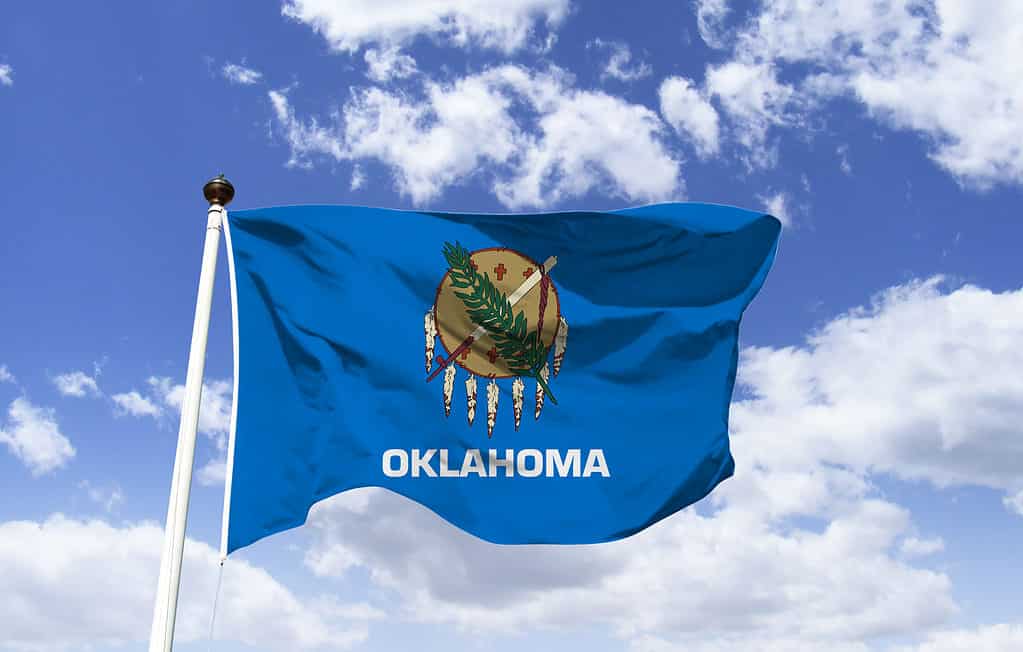The national flag of Oklahoma features a native Osage buffalo-skin crest with seven eagle feathers on a backdrop of Choctaw sky-blue. The olive branch and the Plains ceremonial pipe, which represent Native Americans and European Americans, are positioned over the buffalo shield as symbols of peace. Six golden-brown crosses, representing stars in Native American artwork, are used to embellish the shield.
The blue field was modeled after the Choctaw flag, which was flown by the tribe during the American Civil War and authorized in 1860. Blue represents commitment and faithfulness. The shield’s olive branch and a calumet, which represent defense or protection, show a united people’s desire for peace. This one and New Mexico’s are the only two United States flags that prominently include Native American symbols. However, Massachusetts and Minnesota’s flags do possess state seals that depict Native people. The history, significance, and symbolism of Oklahoma’s flag are explored in more detail below.
Flag of Oklahoma History

The Oklahoma state flag waving along with the national flag of the United States of America.
©rarrarorro/Shutterstock.com
Choctaw chief Kiliahote granted the state its namesake in 1866. A flag wasn’t adopted until 1907 when Oklahoma officially became a state. Four years later, Oklahoma chose its first flag in 1911. The flag had a large white star in the center that was bordered by blue on a red backdrop, and it was red, white, and blue, similar to the American flag. Oklahoma became the 46th state that joined the Union, hence the star’s center was inscribed with the number “46” in blue.
The Daughters of the American Revolution held a competition to design a new flag in 1924 because red flags were thought to be too closely associated with communism. On April 2, 1925, the state flag was selected based on the winning design, which was made by Louise Fluke (a Shawnee, Oklahoma resident). Although it didn’t have the word Oklahoma, it looked similar to the modern flag. The word “Oklahoma” was added in 1941 in an attempt to overcome the pervasive lack of literacy. However, the addition is flawed per the guidelines of the North American Vexillological Association which states that wording should not be put on flags.
As a nod to the state’s agricultural background, the first Oklahoma state flag began flying in the 2010s. In 2015, a new specialty license plate commemorating the first flag was approved by the legislature and adopted by the government. It can often be seen flying alongside the U.S. national flag.
Flag of Oklahoma Colors and Design Meaning:

The Oklahoma flag pattern has a sky-blue background with a shield decorated with crosses and feathers.
©Wasan Ritthawon/Shutterstock.com
An Osage war shield is placed in the center of the Oklahoma flag, which has a sky-blue backdrop. The shield is decorated with six crosses and seven hanging eagle feathers. On the top of the shield, an olive branch and a peace pipe are crossed. Oklahoma is printed in white in the area below. Over the buffalo skin shield are two peace symbols: a ceremonial pipe in the Plains style and an olive branch signifying European Americans.
The shield included tiny crosses that symbolized stars and included the olive branch and calumet as emblems of peace for Europeans and Native Americans. The Oklahoma legislature defined the exact criteria for the flag’s color scheme on November 1, 1988.
Flag of Oklahoma Symbolism

Oklahoma state adopted its first flag in 1911. It has been updated since. Currently, it has a classic buffalo skin shield with 2 peace symbols, 7 eagle feathers, and a blue background.
©Box Lab/Shutterstock.com
Oklahoma adopted its first official flag in 1911. It had a white and blue star in the middle and the number 46 on the flag. This was meant to represent Oklahoma’s admission as the 46th state to the Union. The red backdrop of the flag represented Native Americans. However, due to that flag’s resemblance to communist banners, some people disliked it after World War I. This was particularly true of the state’s commanding general at the time. The flag has since been changed.
The current Oklahoma state flag has a classic buffalo-skin shield with seven eagle feathers on a sky-blue background. Two peace symbols—the calumet, which advocates for Native Americans, and the olive branch, which advocates for European Americans—cover the Osage shield. The current flag ultimately stands for harmony and serenity. This is represented by the feathers and two peace symbols crisscrossed atop the shield in the center.
Up Next:
- The Don’t Tread On Me Flag and Phrase: History, Meaning, and Symbolism
- 5 of the Biggest Spiders in Oklahoma
- The 13 Biggest Lakes in Oklahoma
The photo featured at the top of this post is © railway fx/Shutterstock.com
Sources
- U.S. Flags, Available here: https://www.usflags.com/oklahoma-state-flag.html
- Wikipedia, Available here: https://en.wikipedia.org/wiki/Flag_of_Oklahoma
Thank you for reading! Have some feedback for us? Contact the AZ Animals editorial team.






